- Understanding Strawberry Growth
- Life Cycle of a Strawberry Plant
- Factors Affecting Strawberry Growth
- Conclusion
- Soil Requirements for Strawberries
- Optimal pH Level for Strawberry Growth
- Testing the Soil pH
- Adjusting Soil pH
- Maintaining the Optimal pH
- The Importance of Fertilisation in Maximising Strawberry Harvest
- 1. Nutrient Supply:
- 2. Plant Growth and Development:
- 3. Flowering and Fruit Production:
- 4. Disease Resistance:
- 5. Long-term Soil Health:
- Different Types of Fertilisers
- 1. Granular Fertilisers
- 2. Liquid Fertilisers
- 3. Organic Fertilisers
- Organic Fertilisers: Pros and Cons
- Pros of Organic Fertilisers:
- Cons of Organic Fertilisers:
- Synthetic Fertilisers: Benefits and Drawbacks
- Benefits of Synthetic Fertilisers for Strawberries
- Drawbacks of Synthetic Fertilisers for Strawberries
- Slow-release Fertilisers: Enhancing Nutrient Availability
- Advantages of Slow-release Fertilisers:
- Choosing the Right Slow-release Fertiliser:
- Application of Slow-release Fertilisers:
- Top Three Fertilisers for Strawberry Harvest
- 1. Organic Fertilisers
- 2. Slow-Release Fertilisers
- 3. Complete Fertilisers
- Nitrogen-based Fertilisers: Promoting Lush Growth and Flowering
- Types of Nitrogen-based Fertilisers
- Benefits of Nitrogen-based Fertilisers
- Application of Nitrogen-based Fertilisers
- Question-answer:
- What are the top three fertilisers to maximise strawberry harvest?
- Why is nitrogen important for strawberry plants?
- How can I apply nitrogen fertiliser to strawberry plants?
- What is the purpose of phosphorus in strawberry fertiliser?
- Should I use a slow-release phosphorus fertiliser or a quick-release one for strawberries?
- Why is potassium important for strawberry plants?
- How often should I apply potassium fertiliser to strawberry plants?
- Video: How To Grow The Sweetest Strawberries Ever
When it comes to growing the perfect strawberries, using the right fertilisers can make all the difference. Fertilisers provide essential nutrients for the plants, promoting healthy growth and abundant yields. In this ultimate guide, we’ll explore the top three fertilisers that will help you maximise your strawberry harvest throughout the season.
1. Nitrogen-Rich Fertilisers – Nitrogen is an essential nutrient for strong and healthy strawberry plants. It promotes vigorous growth, improves leaf and stem development, and increases overall plant productivity. Look for fertilisers with a high nitrogen content, such as those labeled with an NPK ratio of 10-5-5 or 20-10-10. Apply these fertilisers in early spring and again after the first harvest to support continuous growth and fruit production.
2. Phosphorus-Enriched Fertilisers – Phosphorus is crucial for flower and fruit formation in strawberry plants. It stimulates root development, enhances flowering, and encourages the production of large, juicy berries. Fertilisers with a higher phosphorus content, such as those with an NPK ratio of 5-10-10 or 10-20-20, are ideal for promoting optimal fruit yield. Apply these fertilisers in early spring or before planting to ensure your strawberry plants have ample access to this vital nutrient.
3. Potassium-Packed Fertilisers – Potassium plays a vital role in overall plant health, including disease resistance and fruit quality. It assists in water and nutrient uptake, increases the plant’s tolerance to drought and cold, and improves the flavor and color of strawberries. Look for fertilisers with a high potassium content, such as those with an NPK ratio of 10-10-20 or 10-10-30. Apply these fertilisers throughout the growing season, starting in early spring and continuing until late summer, to provide consistent nourishment for your strawberry plants.
By incorporating these top three fertilisers into your strawberry growing routine, you can ensure your plants receive the essential nutrients they need to thrive. Whether you’re growing strawberries in a garden, raised beds, or containers, the right fertilisers can maximize your harvest and result in plump and juicy berries throughout the season.
Understanding Strawberry Growth
Before diving into the different fertilizers that can maximize your strawberry harvest, it’s important to understand how strawberries grow and develop throughout the season.
Life Cycle of a Strawberry Plant
A strawberry plant goes through several stages during its life cycle:
- Germination: This is the initial stage, where a small seedling emerges from the seed.
- Establishment: Once the seedling is strong enough, it develops roots and leaves, establishing itself in the soil.
- Growth: During this stage, the plant grows larger and develops more leaves and stems.
- Flower Bud Formation: As the plant matures, it starts forming flower buds, which will eventually develop into strawberries.
- Flowering: The flower buds open up and produce flowers, attracting pollinators such as bees.
- Pollination: Pollinators transfer pollen from the male parts of the flower to the female parts, allowing fertilization to occur.
- Fruit Development: After pollination, the fertilized flowers develop into strawberries. This stage requires proper nutrition and care.
- Harvest: Finally, the strawberries reach maturity and can be harvested.
Factors Affecting Strawberry Growth
Several factors can influence the growth and development of strawberries:
- Temperature: Strawberries thrive in cool to moderate temperatures, ideally between 15-25°C (59-77°F). Extreme heat or cold can slow down growth or damage the plant.
- Light: Strawberries require full sun for optimal growth. Lack of sunlight can result in weak plants and smaller yields.
- Soil Quality: Well-drained, fertile soil with a pH of 5.5-6.5 is ideal for strawberry growth. It should be rich in organic matter and have good water-holding capacity.
- Watering: Consistent and adequate watering is crucial for strawberries. They require moist soil, but not waterlogged conditions. Insufficient watering can lead to stunted growth.
- Nutrition: Providing the right nutrients at each stage of growth is essential. Lack of essential nutrients can result in poor fruit development and lower yields.
Conclusion
Understanding the life cycle and growth factors of strawberries is vital for maximizing your harvest. By providing optimal conditions and using the right fertilizers, you can ensure healthy plants and abundant strawberries throughout the season.
Soil Requirements for Strawberries
Growing strawberries successfully depends on the quality of the soil. Here are the key soil requirements for strawberries:
- Well-drained soil: Strawberries prefer soil that drains well and is not prone to waterlogging. Excess moisture can lead to root rot and other fungal diseases.
- pH level: The ideal pH range for strawberries is between 5.5 and 6.5. Soil that is too acidic or alkaline can affect nutrient availability and hinder plant growth.
- Moisture retention: While strawberries don’t like waterlogged soil, they do require moisture for proper growth. The soil should be able to retain enough moisture without becoming saturated.
- Organic matter: Adding organic matter such as compost or well-rotted manure can improve soil structure and fertility. It also helps with moisture retention and nutrient availability.
- Good drainage: Besides being well-drained, the soil should have good drainage to prevent nutrient leaching and water accumulation near the roots.
Before planting strawberries, it is recommended to test the soil to determine its pH level and nutrient content. This will help identify any necessary amendments and ensure optimal growing conditions for the plants.
Optimal pH Level for Strawberry Growth
Strawberries are a popular and delicious fruit to grow in your garden, but achieving optimal growth requires careful attention to their growing conditions. One important factor to consider is the pH level of the soil, as it directly affects the availability of nutrients to the plants. The optimal pH range for strawberry growth is between 5.5 and 6.5.
When the soil pH is outside of this ideal range, certain nutrients may become unavailable to the plants, leading to stunted growth, poor fruit quality, and susceptibility to diseases. Therefore, it is crucial to test the pH of the soil before planting strawberries and make any necessary adjustments.
Testing the Soil pH
To determine the pH level of your soil, you can use a soil testing kit or send a sample to a local agricultural extension office. These tests will provide you with an accurate measurement of the pH and other important nutrient levels in your soil.
It’s important to note that the pH of the soil can vary throughout your garden, so it’s best to take samples from different areas to get a comprehensive understanding of the soil conditions.
Adjusting Soil pH
If the soil pH is below 5.5, it is considered too acidic for strawberries. In this case, you can raise the pH by adding agricultural lime, also known as garden lime. Follow the instructions on the lime packaging for the recommended amount to apply per square foot of soil.
On the other hand, if the soil pH is above 6.5, it is considered too alkaline for strawberries. To lower the pH, you can add elemental sulfur or peat moss to the soil. Again, follow the instructions on the packaging to apply the appropriate amount per square foot.
Maintaining the Optimal pH

After adjusting the pH to the ideal range, it is important to regularly monitor and maintain the pH levels. Over time, the pH of the soil can shift due to various factors, such as rainfall, fertilization, and organic matter decomposition.
Regular soil testing is recommended, especially before each growing season, to ensure that the pH remains within the optimal range. If necessary, further adjustments can be made using the appropriate amendments.
By maintaining the optimal pH level for strawberry growth, you can provide your plants with the best conditions for healthy development, increased yields, and delicious fruits.
The Importance of Fertilisation in Maximising Strawberry Harvest
Successful strawberry cultivation depends on various factors, and one of the most crucial ones is proper fertilisation. Fertilisers provide essential nutrients to the plants, promoting healthy growth and increasing the yield of your strawberry harvest. Here are a few reasons why fertilisation is important for maximising your strawberry harvest:
1. Nutrient Supply:
Strawberry plants require a wide range of nutrients to grow and develop properly. Fertilisation ensures that these nutrients are available in sufficient quantities for the plants. Nitrogen, phosphorus, and potassium are the primary macronutrients needed by strawberries, and fertilisers help to replenish these nutrients in the soil.
2. Plant Growth and Development:
Fertilisers provide the necessary nutrients that enable the strawberry plants to grow vigorously and develop a robust root system. This, in turn, results in healthier and more productive plants, ultimately leading to a greater strawberry harvest.
3. Flowering and Fruit Production:
Fertilisers play a critical role in the flowering and fruiting stages of strawberry plants. They help to stimulate flower bud formation and improve fruit set, resulting in a higher yield of strawberries. Fertilisers also contribute to the sweetness, size, and overall quality of the berries.
4. Disease Resistance:
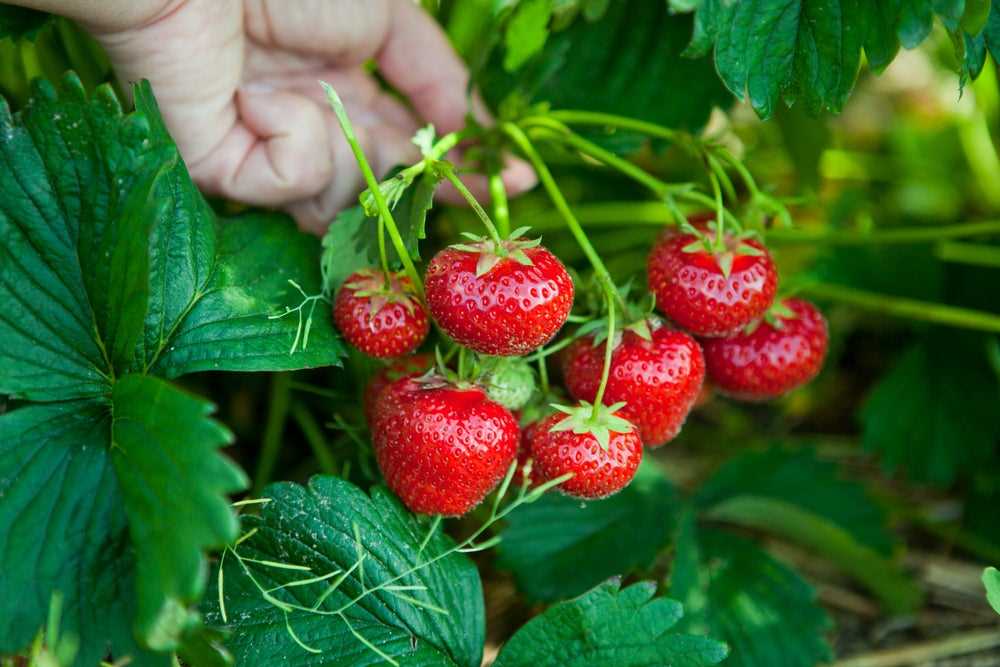
Proper fertilisation strengthens the plants’ immune system and improves their ability to resist diseases, pests, and environmental stresses. Well-nourished strawberry plants are less susceptible to common diseases and are more likely to produce a bountiful harvest.
5. Long-term Soil Health:
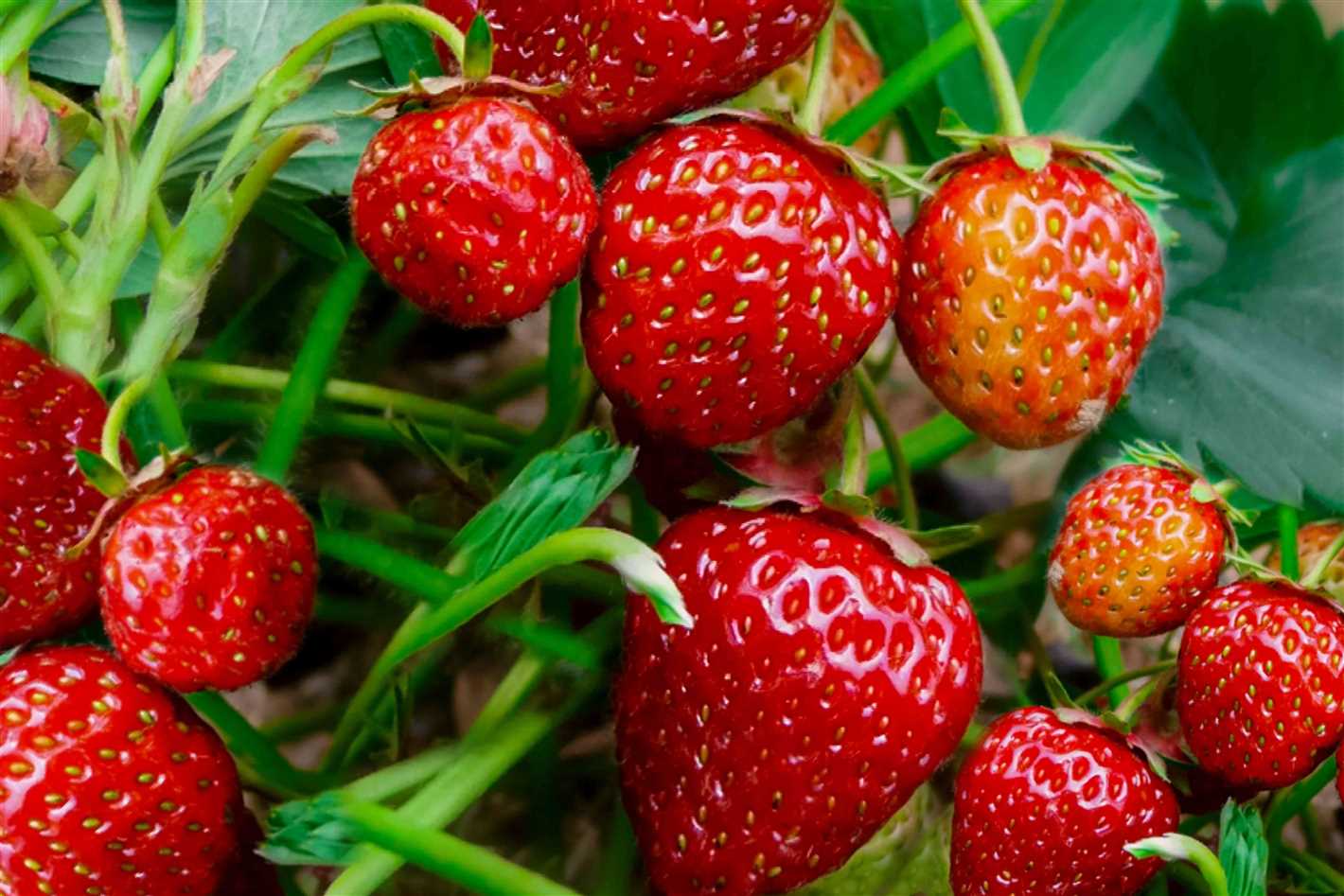
Regular fertilisation not only benefits the current crop but also improves the long-term health of the soil. Fertilisers replenish nutrients that may be depleted over time, maintaining a fertile soil environment for future strawberry crops.
Overall, fertilisation is crucial for maximising your strawberry harvest throughout the season. By providing the necessary nutrients, promoting plant growth, enhancing flowering and fruit production, increasing disease resistance, and improving soil health, proper fertilisation practices can significantly boost the quantity and quality of your strawberry yield.
Different Types of Fertilisers
When it comes to fertilising your strawberry plants, there are several options to choose from. Each type of fertiliser has its own benefits and is suited for different stages of the plant’s growth. Here are three commonly used types of fertilisers:
1. Granular Fertilisers
Granular fertilisers are solid, slow-release fertilisers that provide a long-lasting supply of nutrients to your strawberry plants. They are easy to apply and can be spread evenly around the plants. These fertilisers are typically high in nitrogen, which promotes leaf and stem growth, but they also provide a balanced mix of other essential nutrients.
2. Liquid Fertilisers
Liquid fertilisers are fast-acting and quickly absorbed by the strawberry plants. They are typically mixed with water and applied directly to the soil or foliage. Liquid fertilisers are great for providing a quick boost of nutrients during critical growth stages, such as flowering or fruit development. They are also a good choice for container-grown strawberries, as they can be easily absorbed by the plants.
3. Organic Fertilisers
Organic fertilisers are derived from natural sources such as compost, manure, or plant-based materials. They are an excellent choice for those who prefer to use natural products and promote sustainable gardening practices. Organic fertilisers slowly release nutrients and improve the soil’s structure and fertility over time. They are a great option for long-term soil health and can help prevent nutrient imbalances.
| Type of Fertiliser | Advantages | Disadvantages |
|---|---|---|
| Granular Fertilisers |
|
|
| Liquid Fertilisers |
|
|
| Organic Fertilisers |
|
|
Organic Fertilisers: Pros and Cons
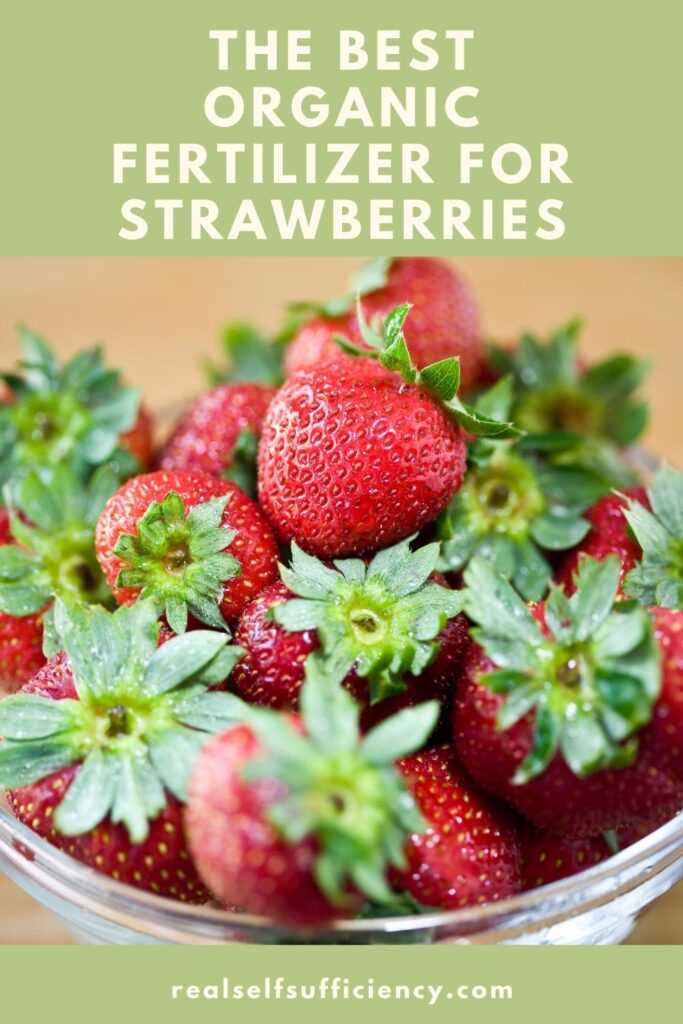
Organic fertilisers, derived from natural sources, offer several advantages and disadvantages compared to synthetic fertilisers. Here are the pros and cons of using organic fertilisers in your strawberry garden:
Pros of Organic Fertilisers:
- Environmentally friendly: Organic fertilisers are derived from natural sources and are considered more environmentally friendly compared to synthetic fertilisers. They do not contain harmful chemicals or synthetic additives that can harm the soil, water, and surrounding ecosystems.
- Slow-release of nutrients: Organic fertilisers release nutrients slowly over time, providing a steady supply of essential elements to the plants. This can help prevent nutrient leaching and reduce the risk of nutrient deficiency or excess.
- Improves soil structure: Organic fertilisers improve soil structure by increasing its ability to retain moisture, allowing better drainage, and enhancing the overall fertility. This can result in healthier strawberry plants with improved root development and nutrient uptake.
- Long-term soil health: Organic fertilisers contribute to long-term soil health and fertility by promoting beneficial microbial activity and improving soil organic matter content. They can help build sustainable, nutrient-rich soils that support healthy plant growth and reduce the need for frequent fertiliser applications.
Cons of Organic Fertilisers:
- Slow nutrient availability: Organic fertilisers generally take longer to break down and release nutrients compared to synthetic fertilisers. This slow nutrient availability may not meet the immediate nutrient demands of the plants, especially during the early stages of growth or when there is a nutrient deficiency.
- Variability in nutrient content: Organic fertilisers can have varying nutrient contents depending on their source, production process, and batch. This variability can make it challenging to accurately determine the nutrient composition and apply the fertiliser at the recommended rates.
- Cost and availability: Organic fertilisers are often more expensive than synthetic fertilisers, mainly due to the production process, sourcing of organic materials, and limited availability. The higher cost and limited availability may make them less accessible for some growers.
- Potential for weed seeds and pathogens: Organic fertilisers, especially those derived from animal manure or plant residues, can potentially contain weed seeds and pathogens. These unwanted elements can introduce weed problems or spread diseases to the strawberry plants if not properly composted or treated.
Considering these pros and cons, organic fertilisers can be a viable option for strawberry growers who prioritize environmental sustainability, long-term soil health, and overall plant well-being. However, it is important to carefully select and use organic fertilisers, take proper soil testing, and monitor plant nutrient needs to ensure optimal strawberry yield and quality.
Synthetic Fertilisers: Benefits and Drawbacks
Synthetic fertilisers, also known as chemical fertilisers, are man-made substances that provide plants with essential nutrients to promote growth. They are commonly used in commercial farming and gardening to maximize crop yields, including strawberries. While synthetic fertilisers offer some benefits for strawberry plants, they also have drawbacks that need to be considered.
Benefits of Synthetic Fertilisers for Strawberries
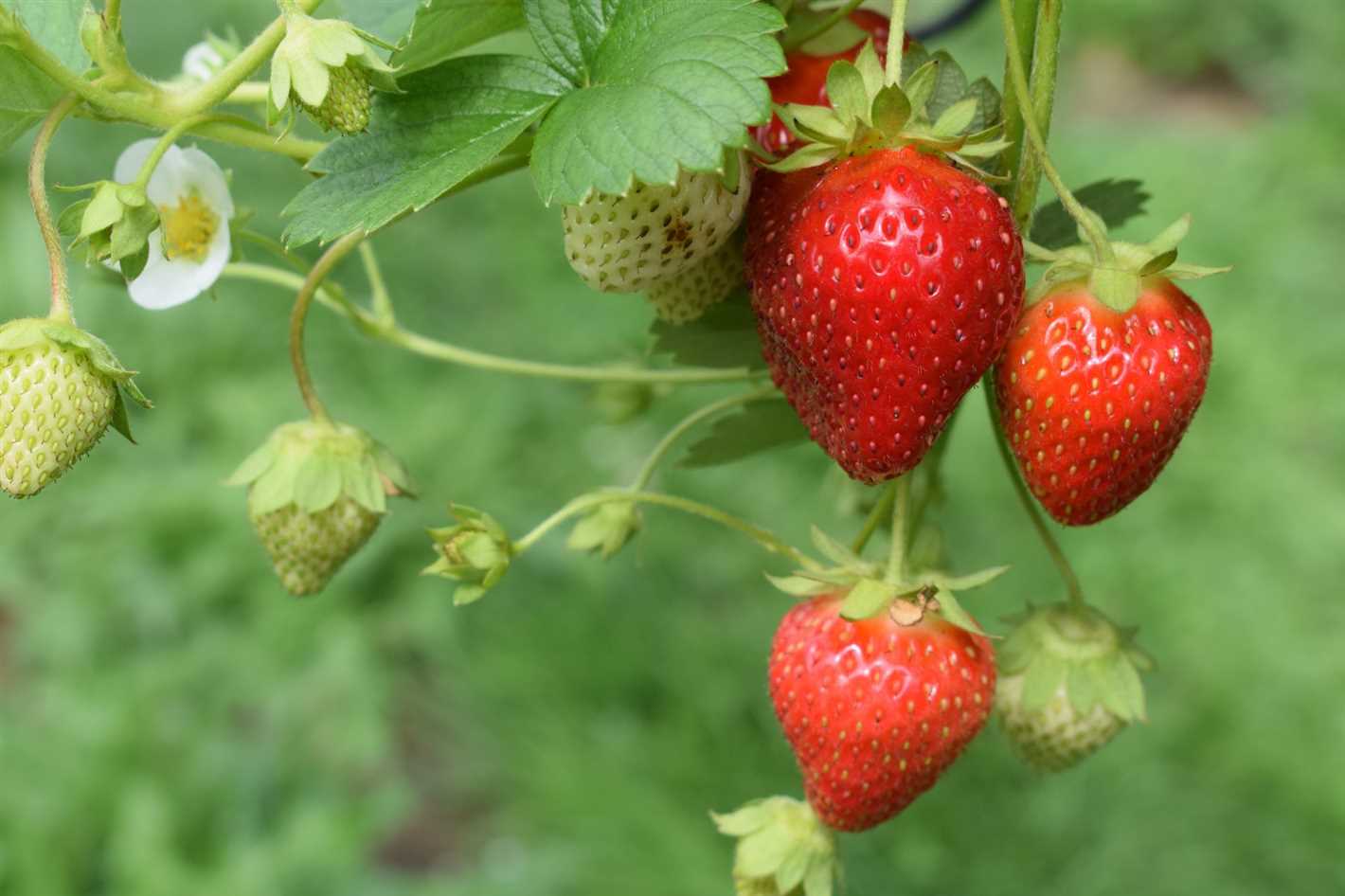
- Nutrient Availability: Synthetic fertilisers are formulated to provide a balanced mix of nutrients that are easily absorbed by plants. This ensures that strawberries receive the necessary elements, such as nitrogen, phosphorus, and potassium, in the right proportions for healthy growth and fruit development.
- Rapid Effect: Synthetic fertilisers are designed to work quickly, providing immediate nutrient availability to plants. This can be particularly beneficial when there is a need to correct nutrient deficiencies or promote rapid growth during critical growth stages of strawberry plants.
- Precision Control: Synthetic fertilisers come in various formulations and can be adjusted to specific nutrient requirements or deficiencies of strawberries based on soil tests or plant tissue analysis. This allows for a more targeted approach to nutrient management, resulting in improved plant health and increased strawberry yields.
Drawbacks of Synthetic Fertilisers for Strawberries
- Environmental Impact: The excessive and improper use of synthetic fertilisers can lead to nutrient runoff into water bodies, causing water pollution and eutrophication. This can harm aquatic ecosystems and contribute to harmful algal blooms. Additionally, the production of synthetic fertilisers requires the consumption of non-renewable resources and contributes to greenhouse gas emissions.
- Soil Degradation: Frequent use of synthetic fertilisers without proper soil management practices can lead to soil degradation. Over time, these fertilisers can cause imbalances in soil pH, nutrient availability, and microbial populations, negatively affecting soil health and fertility.
- Dependency: Continuous reliance on synthetic fertilisers can create a dependency on external inputs, making plants less resilient to natural variations in soil fertility. This can result in decreased nutrient uptake efficiency and reduced plant health in the long term.
In conclusion, synthetic fertilisers can provide immediate and precise nutrient availability for strawberry plants, resulting in increased yields. However, the environmental impact, soil degradation, and dependency associated with their use should be carefully considered. It is essential to adopt sustainable and balanced fertiliser practices that minimize negative impacts while maximizing the benefits for strawberry cultivation.
Slow-release Fertilisers: Enhancing Nutrient Availability
When it comes to growing healthy and productive strawberry plants, providing them with the right nutrients is essential. One type of fertiliser that can help enhance nutrient availability over an extended period is slow-release fertilisers.
Slow-release fertilisers gradually release essential nutrients into the soil, ensuring a steady and consistent supply for the strawberry plants. This slow-release mechanism allows the plants to take up the nutrients as needed, preventing nutrient leaching and potential wastage.
Advantages of Slow-release Fertilisers:
- Long-lasting: Slow-release fertilisers have a slow, steady release of nutrients, providing a consistent supply for several months. This eliminates the need for frequent applications and reduces the risk of over-fertilisation.
- Reduced nutrient loss: The controlled release mechanism of slow-release fertilisers minimises nutrient leaching into the surrounding environment. This helps protect water sources from pollution and preserves the overall ecosystem.
- Improved plant health: Slow-release fertilisers ensure that the plants receive a continuous supply of nutrients, promoting healthy growth, increased resistance to pests and diseases, and better overall plant vigour.
Choosing the Right Slow-release Fertiliser:
When selecting a slow-release fertiliser for your strawberries, consider the following factors:
- NPK ratio: Look for a fertiliser with a balanced ratio of nitrogen (N), phosphorus (P), and potassium (K) to meet the specific nutritional requirements of your strawberry plants. A ratio of 10-10-10 or 14-14-14 is generally suitable.
- Other essential nutrients: Check if the fertiliser contains micronutrients like iron, zinc, and manganese, which are essential for the proper growth and development of strawberries.
- Longevity: Consider the duration of nutrient release. Some slow-release fertilisers release nutrients for up to 3 months, while others can last for 6 months or longer. Choose a fertiliser that matches your desired release timeline.
Application of Slow-release Fertilisers:
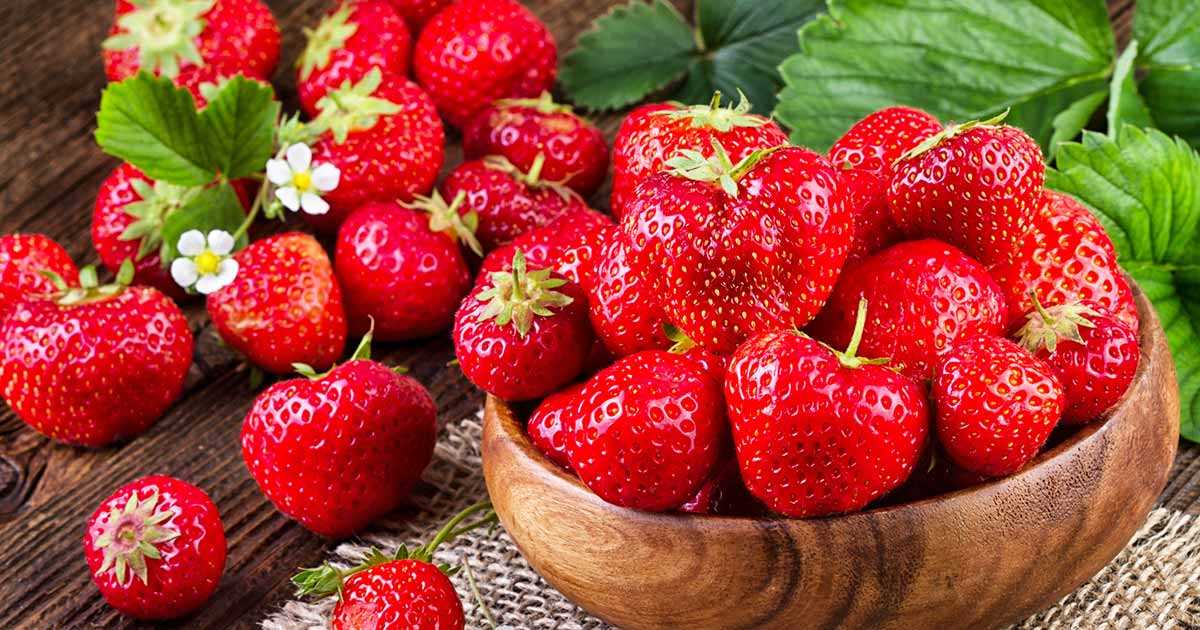
When applying slow-release fertilisers to your strawberry plants, follow these simple steps:
- Carefully read and follow the instructions provided by the fertiliser manufacturer.
- Apply the fertiliser evenly around the base of the plants, ensuring that it does not come into direct contact with the leaves or stems.
- Water the plants thoroughly after applying the fertiliser to help activate the slow-release mechanism.
- Monitor the growth and health of your strawberry plants regularly and make adjustments to the fertiliser application as needed.
By using slow-release fertilisers, you can enhance nutrient availability for your strawberries throughout the growing season, promoting healthy growth, and maximizing your harvest.
Top Three Fertilisers for Strawberry Harvest
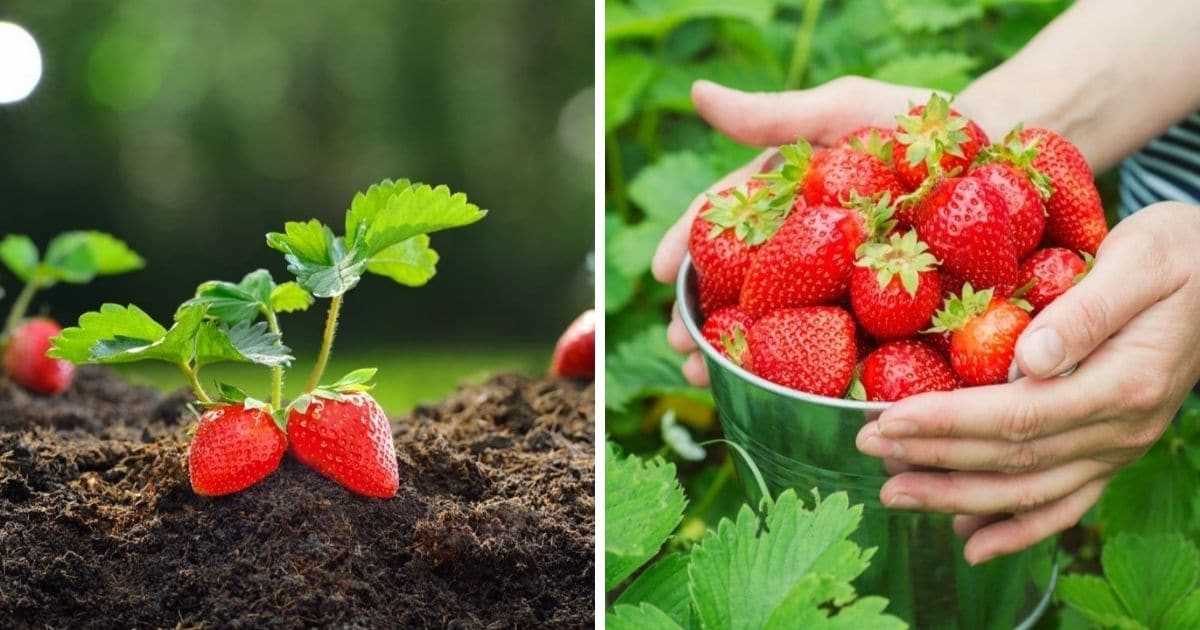
1. Organic Fertilisers
Organic fertilisers are a great choice for strawberry plants as they are derived from natural sources and are environmentally friendly. They provide essential nutrients to the plants without causing any harm to the soil or the surrounding ecosystem. Organic fertilisers such as compost, manure, and seaweed extract are rich in nitrogen, phosphorus, potassium, and other trace elements that help in promoting healthy plant growth and fruit development.
Using organic fertilisers not only improves the quality and taste of strawberries but also enhances the overall health and vitality of the plants. These fertilisers slowly release nutrients into the soil, providing a constant supply of food for the strawberries throughout the growing season.
2. Slow-Release Fertilisers
Slow-release fertilisers are another excellent option for strawberry plants. As the name suggests, these fertilisers release nutrients gradually over an extended period. This ensures that the plants receive a steady supply of essential nutrients without the risk of overfeeding or nutrient leaching.
The slow-release fertilisers are usually available in granular or pellet form, which makes them easy to apply and distribute evenly around the strawberry plants. This type of fertiliser is especially beneficial for strawberry plants as it helps in preventing nutrient deficiencies and promotes optimal plant growth and fruit production.
3. Complete Fertilisers
Complete fertilisers are formulated to provide a balanced combination of essential nutrients to the plants. They contain a mix of nitrogen, phosphorus, and potassium, along with other micronutrients that strawberries require for healthy growth.
Using a complete fertiliser ensures that strawberry plants receive all the necessary nutrients in the right proportions. This helps in maintaining the overall health and vigor of the plants, leading to better fruit set and quality. Complete fertilisers are available in both organic and synthetic forms, making them suitable for different gardening preferences.
When using complete fertilisers, it is essential to follow the recommended application rates to avoid overfertilization, which can burn the plants and harm the soil.
| Fertiliser Type | Advantages | Disadvantages |
|---|---|---|
| Organic Fertilisers |
|
|
| Slow-Release Fertilisers |
|
|
| Complete Fertilisers |
|
|
Nitrogen-based Fertilisers: Promoting Lush Growth and Flowering
Nitrogen is an essential nutrient for strawberry plants as it plays a crucial role in promoting lush growth and flowering. Nitrogen-based fertilisers are a popular choice among strawberry growers due to their ability to provide an abundant supply of this important nutrient.
Types of Nitrogen-based Fertilisers
There are several types of nitrogen-based fertilisers available on the market:
- Urea: Urea is a common nitrogen-based fertiliser that is highly effective in promoting vigorous plant growth. It is a soluble form of nitrogen and can be easily absorbed by the strawberry plants.
- Ammonium Nitrate: Ammonium nitrate is another nitrogen-based fertiliser that is widely used in strawberry cultivation. It provides a quick release of nitrogen to the plants, resulting in rapid growth and flowering.
- Ammonium Sulfate: Ammonium sulfate is a nitrogen-based fertiliser that provides both nitrogen and sulfur to the strawberry plants. Sulfur is an important nutrient for the healthy development of leaves, stems, and roots.
Benefits of Nitrogen-based Fertilisers
Nitrogen-based fertilisers offer several benefits when used in strawberry cultivation:
- Promotes lush growth: Nitrogen is known for its ability to stimulate plant growth and enhance the overall health of strawberry plants. It helps in the development of strong and healthy foliage, which is essential for optimal fruit production.
- Enhances flowering: Nitrogen promotes the formation of flower buds and ensures a higher yield of strawberries. It plays a vital role in the development of flowers and helps in the production of large, vibrant, and juicy strawberries.
- Improves fruit quality: Nitrogen-based fertilisers contribute to the improvement of fruit quality by enhancing the size, color, and taste of the strawberries. They also help in increasing the sugar content in the fruits, making them sweeter and more flavorful.
- Increases disease resistance: Adequate nitrogen levels in strawberry plants can help improve their resistance to diseases and pests. Well-nourished plants are better equipped to defend themselves against various pathogens and insects.
Application of Nitrogen-based Fertilisers
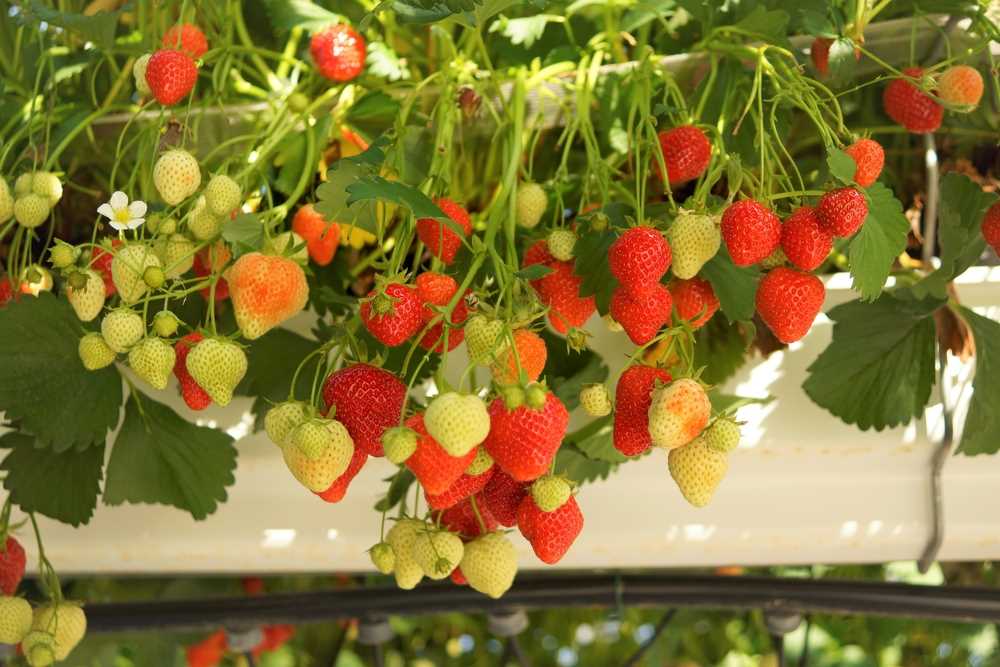
When applying nitrogen-based fertilisers to strawberry plants, it is essential to follow the recommended dosage and application schedule. Overuse of nitrogen can lead to excessive vegetative growth at the expense of fruit production.
It is advisable to apply nitrogen-based fertilisers during the early stages of plant growth and flowering to ensure optimal results. Regular monitoring of the plants’ nitrogen levels and adjusting the fertiliser application accordingly is crucial for maintaining a healthy strawberry crop.
| Nitrogen-based Fertiliser | Application Rate | Application Timing |
|---|---|---|
| Urea | 1-2 pounds per 100 square feet | Early spring before planting |
| Ammonium Nitrate | 1/2 pound per 100 square feet | Early spring before planting |
| Ammonium Sulfate | 1/2 pound per 100 square feet | Early spring before planting |
By incorporating nitrogen-based fertilisers into your strawberry cultivation routine, you can promote lush growth, enhance flowering, and maximize your strawberry harvest throughout the season.
Question-answer:
What are the top three fertilisers to maximise strawberry harvest?
The top three fertilisers to maximise strawberry harvest are nitrogen, phosphorus, and potassium.
Why is nitrogen important for strawberry plants?
Nitrogen is important for strawberry plants because it helps promote leaf and stem growth, which leads to a healthy and productive plant.
How can I apply nitrogen fertiliser to strawberry plants?
You can apply nitrogen fertiliser to strawberry plants by mixing it into the soil before planting or by using a liquid nitrogen fertiliser during the growing season.
What is the purpose of phosphorus in strawberry fertiliser?
Phosphorus in strawberry fertilisers helps promote root development and flowering, resulting in healthier and more abundant strawberries.
Should I use a slow-release phosphorus fertiliser or a quick-release one for strawberries?
It is recommended to use a slow-release phosphorus fertiliser for strawberries as it provides a steady supply of nutrients over time and prevents the risk of over-fertilising.
Why is potassium important for strawberry plants?
Potassium is important for strawberry plants as it helps improve fruit quality, enhances disease resistance, and contributes to overall plant health and vigour.
How often should I apply potassium fertiliser to strawberry plants?
It is best to apply potassium fertiliser to strawberry plants every 3-4 weeks during the growing season, starting after the plants have started to flower.







